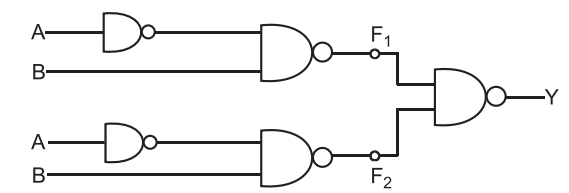Advanced Microprocessors
- Among the following the slowest ADC is—
-
View Hint View Answer Discuss in Forum
Integrating type ADC are more accurate but slow.
Correct Option: C
Integrating type ADC are more accurate but slow.
- The number of comparator carried out in a 4 bit flashtype A/D converter is—
-
View Hint View Answer Discuss in Forum
No. of comparator required = 2n – 1
(where, n = no. of bits)
= 24 – 1 = 15
Hence alternative (B) is the correct answer.Correct Option: B
No. of comparator required = 2n – 1
(where, n = no. of bits)
= 24 – 1 = 15
Hence alternative (B) is the correct answer.
- A 10 bit A/D convertor is used to digitize an analog signal in the 0 to 5 V range. The maximum peak to peak ripple voltage that can be allowed in the d.c. supply voltage is—
-
View Hint View Answer Discuss in Forum
Smallest incremental change = 1 = 1 210 1024
For 5V,5 = nearly 5 mV 1024
Hence alternative (D) is the correct answer.Correct Option: D
Smallest incremental change = 1 = 1 210 1024
For 5V,5 = nearly 5 mV 1024
Hence alternative (D) is the correct answer.
- How many NAND gates are required to make AB + BA?
-
View Hint View Answer Discuss in Forum

Y = AB + AB
This means, half adder requires 4 NAND gates. Hence alternative (C) is the correct answer.Correct Option: C

Y = AB + AB
This means, half adder requires 4 NAND gates. Hence alternative (C) is the correct answer.
- Write output—

-
View Hint View Answer Discuss in Forum

F1 = (AB)′
F2 = (BA)′
Y = F1F2 = [( AB)′ ( BA)′]′
= [(A + B′) ( B + A)] ′ = AB + BA
Alternative Method:
NAND-NAND circuit can be replaced by AND-OR Hence,
Now, F1 = AB,
F2 = BA
Y=F1 + F2 = AB + BA (this is shortcut method).Correct Option: D

F1 = (AB)′
F2 = (BA)′
Y = F1F2 = [( AB)′ ( BA)′]′
= [(A + B′) ( B + A)] ′ = AB + BA
Alternative Method:
NAND-NAND circuit can be replaced by AND-OR Hence,
Now, F1 = AB,
F2 = BA
Y=F1 + F2 = AB + BA (this is shortcut method).

